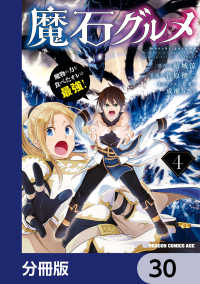- ホーム
- > 洋書
- > 英文書
- > Politics / International Relations
Full Description
The Games Presidents Play provides a new way to view the American presidency. Looking at the athletic strengths, feats, and shortcomings of our presidents, John Sayle Watterson explores not only their health, physical attributes, personalities, and sports IQs, but also the increasing trend of Americans in the past century to equate sporting achievements with courage, manliness, and political competence. The author of College Football begins with George Washington, whose athleticism contributed to his success on the battlefield and may well have contributed to the birth of the republic. He moves seamlessly into the nineteenth century when, for presidents like Jackson, Lincoln, and Cleveland, frontier sports were part of their formative years. With the twentieth-century presidents-most notably the hyperactive and headline-grabbing Theodore Roosevelt-Watterson shows how the growth of mass media and the improved means of transportation transformed presidential sports into both a form of recreation and a means of establishing a positive self-image. Modern presidents have used sports with varying degrees of success.
Herbert Hoover fled Washington on weekends to the trout pools of Camp Rapidan in the Blue Ridge to escape relentless pressures and public criticism during the Great Depression. Franklin Roosevelt demonstrated remarkable physical endurance in his campaign to restore his ravaged body from polio. An obsessive love affair with golf became an issue for Dwight Eisenhower in his campaign for reelection in 1956. Richard Nixon, a former third-string college football lineman, placed calls to Coach George Allen of the Washington Redskins, once suggesting a trick play in a big game. From the opening pitch of the baseball season to presenting awards to Olympic champions, our sports culture asks the president to play an increasingly active role. Sports, Watterson argues, open a window into the presidency, shedding new light on presidential behavior and offering new perspectives on the office and the sporting men-and women-who have and will occupy it .
Contents
Preface
Introduction
Part I: Foundations
1. In the Beginning
2. The Sporting Frontier
3. Barely Visible to Press and Public
Part II: The Man Who Changed Everything
4. Theodore Roosevelt: Climbing the Mountain
5. Sports and the Presidency: The Founding Father
6. Inside TR's Sporting Presidency
Part III: Sports: Acceptable but not Required
7. William Howard Taft: A Large Legacy
8. Woodrow Wilson: More than Just a Game
9. Warren Harding: The Wager He Didn't Win
10. Calvin Coolidge: Grace, under Pressure
11. Herbert Hoover: No Place to Hide
12. Franklin Delano Roosevelt: Politically and Physically Challenged
Part IV: Flight from Washington
13. Harry S Truman: Striding—and Flying—into History
14. Dwight D. Eisenhower: Hero under Assault
15. John F. Kennedy: Swimming into Politics
16. Lyndon Johnson: The Games He Didn't Play
Part V: In the Public Eye
17. Richard Nixon: Show Me a Good Loser
18. Gerald Ford: The Pigskin President
19. Jimmy Carter: More Than Meets the Eye
20. Ronald Reagan: Creating a Sports Legend
21. George H. W. Bush: TR Revisited
Part VI: New Players, Old Games
22. Bill Clinton: Oh, How He Played the Game
23. George W. Bush: From Bush Leagues to the Majors
Conclusion
Appendix: Ranking the Presidents
Notes
Suggested Reading
Index








